Revue Biblique on The Case for a Proto-Gospel
This review, from one of the oldest academic biblical magazines, is in French. With the help of the editor, I had the following extract translated into English. The review uses traditional abbreviations for several terms. “A” is the author, i.e., Me.
It is clear that Jn is very different from the synoptics, and in particular from Mc, but the A. claims that Jn made changes because he disagreed. Still, they share many episodes, albeit without many verbal agreements. A first chapter is attached to Jn 6, which brings together elements dispersed in Mk 6 and 8 (multiplication of the loaves, walking on the waters, etc.); next, the story of the paralytic of Capernaum is compared to the story of the cripple of Bethzatha of Jn 5; then the discourse on the bread of life is related to the rejection of Jesus by his own; then, the episodes relating to the beginning of Jesus’ mission highlight the role of John the Baptist; then Jesus’ last visit to Jerusalem is examined, followed by the plot against Jesus, the account of the Eucharist, the Jewish trial of Jesus, the appearance before Pilate, the crucifixion, and finally the resurrection. Finally, the A. proposes a restoration of the supposed protevangel: it is essentially Mc, with some intrusions of Jn and Lc. The author considers that three criteria prove his thesis: a good number of John’s stories have parallels in Mark; the order of the pericopes is most often similar; John cannot have followed either Mark or Luke directly, which presupposes an earlier state.
This result has required long analyses and very ingenious considerations, which could be discussed in detail, but the overall remark to be made is that the interest of this research is not apparent.





